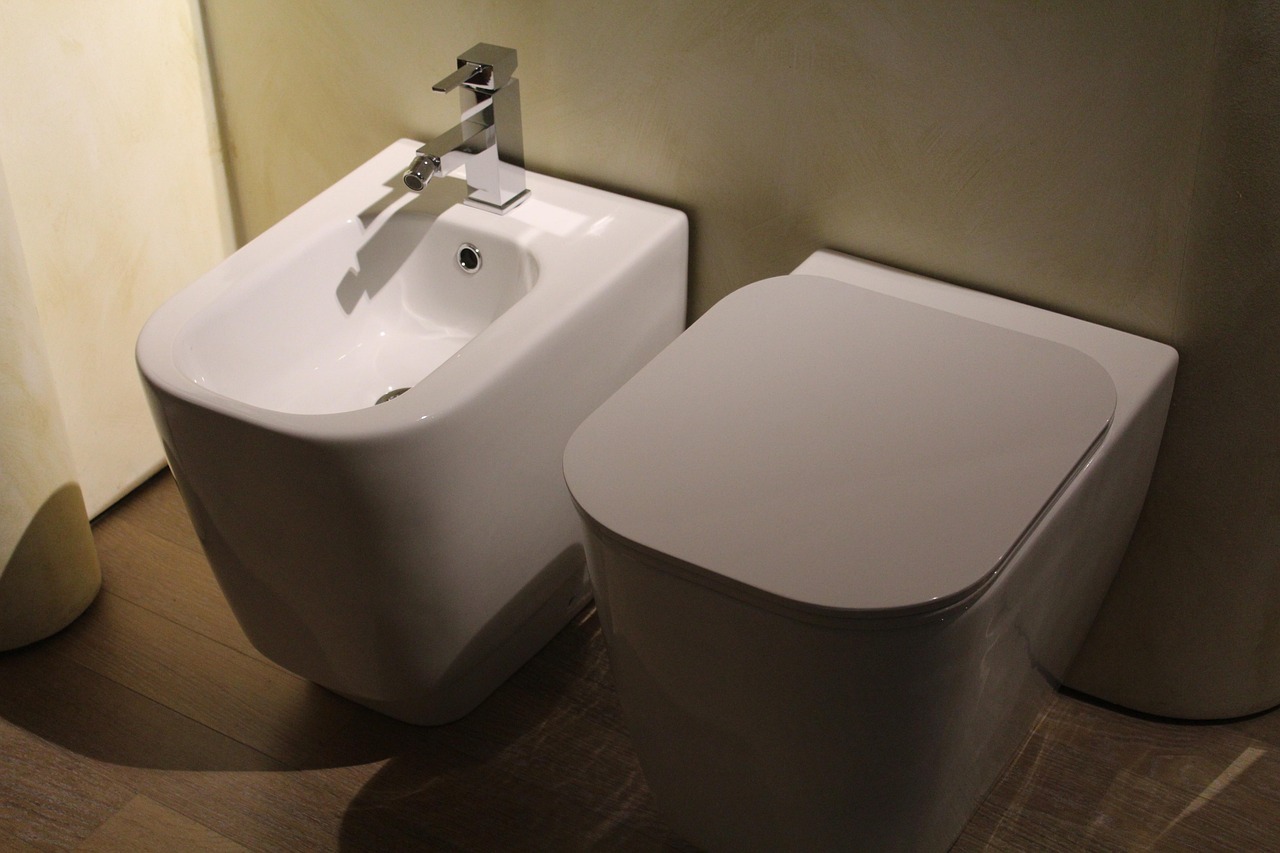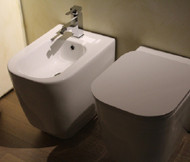How to Use a Bidet and Why They’re a Game-Changer for Your Bathroom
22nd Jul 2025

Bidets are a popular bathroom fixture across Europe, but they're still a rare sight in many homes in the UK. If you've been wondering whether a bidet is worth considering for your bathroom renovation but aren't sure where to start, we've got you covered.
We'll walk you through how these accessories work and the surprising benefits they can bring to your bathroom routine. Plus, Brian Toward, CEO at Wholesale Domestic, is here with tips to help you decide if a bidet is the right fit for your home.
Contents:
- What is a bidet?
- How does a bidet work?
- What are the benefits of using a bidet?
- How to properly use a bidet
- Frequently asked questions
What is a bidet?
A bidet is a bathroom fixture in the shape of a bowl that’s designed to help you clean yourself after using the toilet. Rather than relying on standard toilet paper that can be abrasive and spread bacteria around, it uses a gentle stream of water to provide a refreshing and more hygienic alternative.
While traditional bidets tend to be standalone units placed next to the toilet, modern versions are often built right into the toilet seat or added as an attachment to an existing toilet model. This makes them easier to install and more compact, which is especially important when you're trying to maximise space in smaller bathrooms.
Bidets are a quick and efficient way to feel fresh, and once you've tried them, you'll wonder how you've ever lived without one!
How does a bidet work?
A bidet has a nozzle (or sometimes multiple nozzles) that directs a steady stream of water that you can use to clean yourself after using the toilet. The best part is that you can adjust the water pressure and temperature to make sure it's just right for you.
What are the benefits of using a bidet?
You might be thinking, "Why use a bidet when I've got toilet paper?" But once you start using one, you'll immediately notice the difference. From improving your health and personal hygiene to helping you save money, bidets bring a lot to the table (or, rather, the bathroom).
Here are just some of the reasons why having a bidet could be a great addition to your bathroom:
Health benefits
One of the biggest benefits of using a bidet is the positive impact it can have on your health, especially when it comes to boosting your hygiene. Bidets use water, rather than rough toilet paper, to clean, which can be gentler on your skin and prevent unnecessary irritation.
When you're using toilet paper a lot, it can be pretty harsh on your skin, especially if you're prone to sensitivity. A bidet is a gentler way to freshen up, and it helps with hygiene as you're giving yourself a more thorough clean that washes the bacteria away rather than moving it around.
Financial benefits
A bidet seems like a big investment at first, but the long-term savings can be impressive.
Brian says: "A bidet pays for itself over time. On average, people in the UK go through 127 rolls of toilet paper each year, and leading brands cost around 50p per roll. While that may not seem like much, it adds up pretty quickly!”
“With a bidet, you use less paper, so your costs drop. Plus, you're saving money on plumbing repairs for common bathroom problems like a clogged toilet."
Environmental benefits
Using a bidet has some significant environmental benefits, the biggest of which is reducing your reliance on toilet paper. According to National Geographic, around 27,000 trees' worth of toilet paper is flushed daily, so the less paper you use, the better.
How to use a traditional bidet
The idea of using a bidet might seem intimidating, especially if you've never tried one before. But don't worry – it's much easier than you'd think, and once you get the hang of it, it's just another part of your everyday bathroom routine.
Let's break it down step-by-step:
1. Fill the bidet
The first step is to turn on the tap and fill the bidet basin with water, while also adjusting the temperature until it’s comfortable, making sure it's not too hot or too cold.
Finding the right water temperature is vital – too hot and it can be uncomfortable, too cold and it won’t feel refreshing and might even give you a shock! If you like using soap to feel extra clean, make sure it’s bidet-safe so it doesn’t cause any irritation to your skin or blockages in the plumbing. A little goes a long way, so you don’t need much.
2. Sit on the bidet
Next, it’s time to sit on the bidet to clean yourself. There are two ways of doing this: you can either straddle the bidet facing the taps, which lets you easily adjust the water temperature and direction as needed, or sit facing away from the taps, like you would on a toilet.
Most people find it more natural to sit facing away from the taps, just like you would on a regular toilet. But if you want to adjust the water pressure or temperature as you go, it might be a better idea to face the taps, as this gives you more control. Both positions work well – it’s all about what feels comfortable to you.
3. Clean yourself thoroughly
Once seated, it’s time to clean yourself. Gently use the water stream, along with your hands, to clean yourself just like you would in the bath or shower. The beauty of a bidet is that it offers a much more thorough clean compared to regular toilet paper, and the water pressure is adjustable, so you can start with a gentle flow and gradually increase it as needed. Take your time and let the water do the hard work for you.
4. Drain the water
This is a quick and simple step, just pull the plug and you’re good to go. Make sure you give the bidet time to drain completely, so there’s no water left in the basin. This keeps everything clean and dry.
5. Dry off
Once you finish the bidet, you'll want to dry off. While it might be tempting to skip this step, it's important to make sure you're fully dry to avoid any skin irritation. To do this, you can use toilet paper or a designated towel – some bidets even have a built-in air dryer for that added convenience.
How to use an integrated bidet
An integrated bidet is a convenient all-in-one solution where the bidet functions are built right into your toilet seat. These models often come with adjustable settings for water temperature, pressure, and nozzle positioning, making them a simple and effective way to stay clean and fresh.
Here's how to use one:
Brian explains: “Using an integrated bidet is easy. All you need to do is sit down like you normally would on the toilet, then hit the button to start the water flow. Most models let you adjust the water pressure and temperature, so you can find what feels best for you.”
“A great thing about integrated bidets is that many even have a self-cleaning nozzle feature, so you don’t have to worry about it getting dirty. Once you’ve finished, just press the button to stop the water, then use some toilet paper or a towel to dry off," he adds.
Frequently asked questions
Are bidets legal in the UK?
Brian explains: "Bidets are completely legal in the UK, but you do need to be mindful of plumbing regulations. The key thing is making sure that any bidet installation is carried out properly and that everything adheres to the Water Supply (Water Fittings) Regulations 1999. These regulations are designed to prevent contamination of the water supply, so it's crucial to have a professional do the installation if you're unsure about getting it right."
Do you need planning permission for a bidet?
In most cases, you do not need planning permission to install a bidet in your home. However, there are important plumbing and water supply regulations you must follow to ensure the installation is compliant.
If the bidet features an ascending spray (directing water upwards) or includes a flexible hose, you must inform your local water supplier before installation. These types of fittings can pose a backflow risk—where used water could potentially flow back into the mains supply due to a drop in pressure or system failure. This is considered a contamination risk under the Water Supply (Water Fittings) Regulations 1999. To comply, your bidet must be fitted with an appropriate backflow prevention device. Your water supplier may require you to submit details or have the installation inspected.
Always check with your water supplier or a qualified plumber to ensure you're meeting current regulations.
Can a bidet damage your plumbing?
In general, bidets themselves do not damage plumbing, but incorrect installation, high water pressure, or not maintaining them properly can all lead to plumbing issues.
Brian explains: "Bidets are designed to be gentle on your plumbing, but like any other fixture, they need to be installed correctly. If the installation is done poorly or the water pressure is too high, you could end up with leaks or pressure issues. It's important to follow the manufacturer's instructions and make sure that the plumbing is set up properly."
Shop bidets at Wholesale Domestic
Now that you know all about the benefits of installing a bidet and how to use one, it's time to bring that luxury and convenience to your own bathroom. At Wholesale Domestic, we have a fantastic range of bidets to suit all budgets.
Whether you're upgrading your existing toilet setup or adding a bidet as part of a full renovation, we've got you covered with high-quality toilet accessories designed for easy use.
Looking for more bathroom inspiration? Head on over to our blog. Or, for help finding the perfect bidet for your space, contact us today.

 FREE delivery over £500*
FREE delivery over £500* Visit our showrooms
Visit our showrooms Finance options available*
Finance options available* Apply for a Trade Account
Apply for a Trade Account